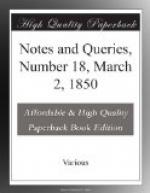When we announced Mr. Archer’s projected work, entitled Vestiges of Old London, a Series of finished Etchings from Original Drawings, with Descriptions, Historical Associations, and other References, we spoke of it as one likely, we thought, to prove of especial interest. The appearance of the first Number justifies to the fullest our anticipation. The pictorial representations are replete {287} with variety, and the literary illustrations full of a pleasant gossipping anecdotical character. The first plate shows us The Old Bulk Shop at Temple Bar, occupied by successive generations of fishmongers, and doubtless well remembered by most of our readers; although no trace of it any longer exists. The House of John Dryden, in Fetter Lane, so designated on the authority of the late Mr. Upcott, forms the second plate; and is followed by The Altar of Diana, discovered in Foster Lane, Cheapside, in December, 1830. The Drapers’ Almshouses, Crutched Friars, is the next illustration, which again is contrasted by a plate of Roman Vestiges, full of interest to those who like to investigate the Roman occupation of our metropolis; and this first part concludes with a view of The Old Chapel of St. Bartholomew, Kingsland. The work is executed in a style to delight London antiquaries, and charm those who delight to illustrate Pennant.
The approaching Exhibition of Works of Ancient and Mediaeval Art at the rooms of the Society of Arts in the Adelphi, promises to be one of the most interesting displays of the kind ever exhibited in this or any other city. The possessors of objects of beauty and rarity have vied with each other in placing at the disposal of the Committee their choicest specimens; and the inhabitants and visitors of the metropolis will shortly have an opportunity of judging how numerous are the relics of “barbaric pomp and gold” which are still left to us, and how much of beauty of design, and “skill in workmanship” were displayed by the “hard-handed” men of the good old times, to justify the enthusiasm of the antiquary, and gratify the man of taste.
We have received, but at a moment too late to notice as it deserves, the Catalogue of very choice Books, and Books printed on vellum, the property of the late Mr. Rodd, which are to be sold by Messrs. Sotheby, at their rooms in Wellington Street, on Monday next. As a specimen, perhaps the most remarkable of this collection, we may point out the set of the Works of Thomas Aquinas, in 17 folio volumes, bound in 21, and which is well described as
“A magnificent set of Books, presenting one of the finest specimens, and at the same time the most extensive work, ever printed upon vellum. This copy was presented by Pope Pius V. to Philip II., king of Spain, and was deposited in the library of the Escurial, whence it was taken during the occupation of Spain by Bonaparte. The only other copy known is in the National Library, Paris. It is the best edition of this author’s works.”
We have received the following Catalogues:




